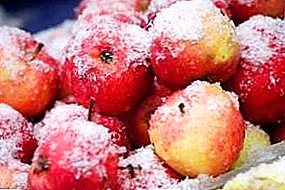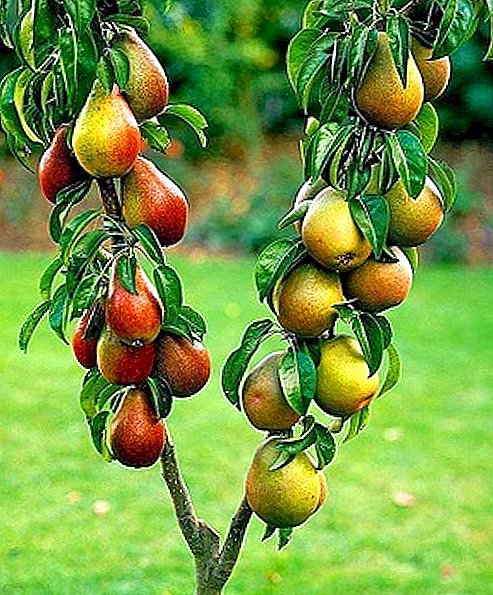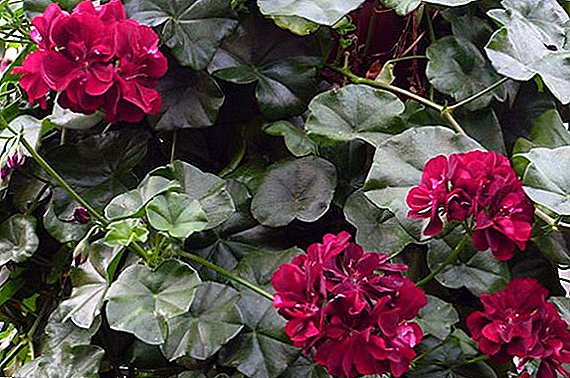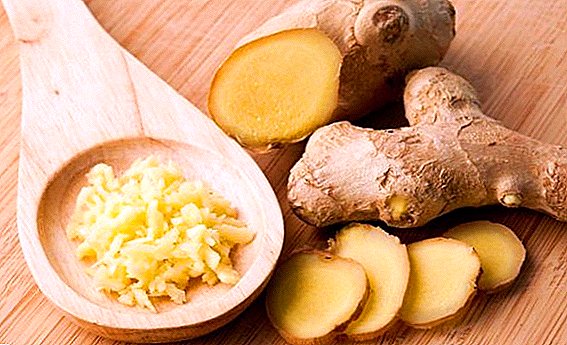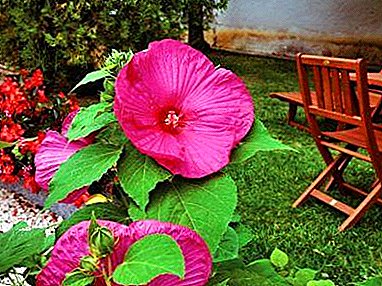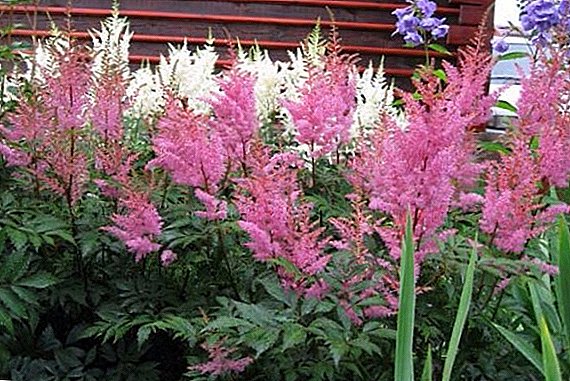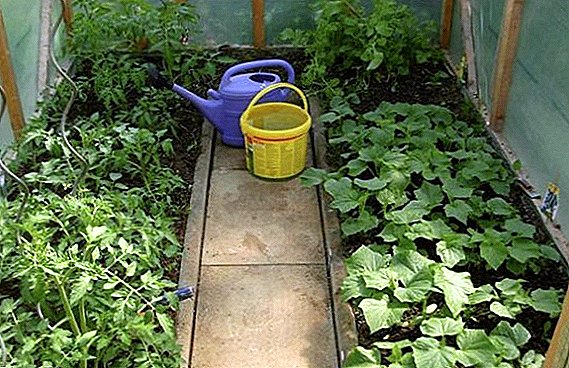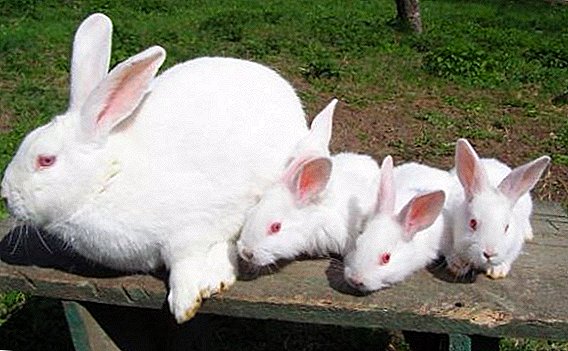 Among all breeds of domestic rabbits, the white pannon stands out for its high productivity and excellent productivity indicators. This is a breed of meat direction, which, with proper care, will allow you to get good and tender meat in fairly large quantities. Features of the content of such rabbits, we consider in the article.
Among all breeds of domestic rabbits, the white pannon stands out for its high productivity and excellent productivity indicators. This is a breed of meat direction, which, with proper care, will allow you to get good and tender meat in fairly large quantities. Features of the content of such rabbits, we consider in the article.
Description and Features
White pannon belongs to the broiler type of animals. It was obtained by crossing a white giant with Californian and New Zealand rabbits, and the result of this experiment exceeded all expectations of breeders. To be convinced of a large number of advantages of representatives of this breed, rather enough to understand all characteristics. 
Appearance and physique
These attractive animals have an elongated, elongated body, a compact and neatly folded head, with red eyes and middle ears on it. The coat color is bright white, which, in combination with red eyes, produces albinos in rabbits.
Under the thin skin, tight to the body, pronounced muscles are well visible. The chest is not very wide, but it seems powerful enough. The coat is thick, which makes the rabbits very fluffy. There is a lot of wool on the pads, thanks to which the animals can move freely around the mesh floor of the cells without any negative consequences for the limbs.
Any blotches on a pure white fur coat are considered unacceptable and cause the white pannon to be rejected.
Did you know? Far from all breeders recognize white pannon as a separate breed, considering it to be just a hybrid, unable to pass on all the characteristics of the next generation. However, if you avoid closely related mating, the offspring will still have the main characteristics of the parents.
Productive characteristics
In addition to the attractive appearance, white pannony differ and high productive characteristics expressed in the following terms:
- rabbits weight - 5-6 kg;
- the number of okrols per year - 7;
- the number of baby rabbits in one litter is about 10;
- weight gain per day (norm) - from 40 g;
- age for slaughter - 90-120 days (by this time the youngsters reach a weight of 3-3.5 kg);
- meat yield - up to 62%.
 In addition, the survival rate of young stock is high: the rabbits grow very fast and gain weight, and the females are fully ready for mating at the age of three months.
In addition, the survival rate of young stock is high: the rabbits grow very fast and gain weight, and the females are fully ready for mating at the age of three months.
It is interesting to learn about the properties, values and cooking rabbit meat.
Conditions of detention
All representatives of the white pannon breed do not have high requirements for conditions of detention and feel equally well at both low and high temperatures (optimal values are + 20 ... + 25 ° C).
Extremely undesirable will be sharp temperature drops, increased air humidity (over 50-65%), drafts or direct sunlight, from which animals cannot shelter. It is also worth paying attention to the number of individuals in one cage: overcrowding threatens with the development of diseases, to which in normal conditions animals have good immunity.
Standard cage for rabbits that have reached puberty should have the following parameters:
- length - 80-130 cm;
- width - 60-80 cm;
- height - from 40 cm.
 By arranging the rabbitry, you can use wood, but it is not a durable material that quickly becomes damp and rot. The metal construction will become a much more rational solution, because besides durability it has some other advantages - for example, reducing the loss from rats.
By arranging the rabbitry, you can use wood, but it is not a durable material that quickly becomes damp and rot. The metal construction will become a much more rational solution, because besides durability it has some other advantages - for example, reducing the loss from rats.
The floor may be reticulated, but even in this case regular cleaning is a must. In addition, when designing a cage, it is better to make it horizontal and not deepen: this way you can easily get animals.
As for the internal filling of the cage, it is necessary to install troughs and drinkers along the entire perimeter, such that water and feed are not scattered around the cage. As a litter, you can use dry hay, only it will have to be changed often so that it does not become moldy and does not become a source of pathogens.
Learn more about rabbit hygiene and home rabbits.
How to care
Timely cleaning and disinfection of rabbit cells is one of the main requirements for caring for them. Disinfection of feeders and drinkers using soda solution is carried out 1 time per 10 days, and a complete cleaning of the internal space of the cage with the processing of all surfaces must be performed at least 1 time per month. You also need to ensure that rodents do not appear in the cages, because mice and rats often become the main sources of many dangerous diseases, and sometimes they also eat rabbits.  If a cage of dry hay or grass is provided on the floor of the cage, then it is replaced at least once every 7 days, and even with a large population of livestock. Soaking in rabbit excrement, bedding often becomes the cause of the emergence of a disease, although representatives of the white pannon breed are distinguished by relatively good health. In order to support it and prevent possible infection with an ailment, it is important to carry out vaccination in a timely manner, starting from an early age.
If a cage of dry hay or grass is provided on the floor of the cage, then it is replaced at least once every 7 days, and even with a large population of livestock. Soaking in rabbit excrement, bedding often becomes the cause of the emergence of a disease, although representatives of the white pannon breed are distinguished by relatively good health. In order to support it and prevent possible infection with an ailment, it is important to carry out vaccination in a timely manner, starting from an early age.
The first vaccine is given to young animals at the age of 45 days, after another two weeks a second vaccination is performed, and after 20 days another one is given. Some breeders vaccinate rabbits for the fourth time (two weeks after the third vaccination), but, as practice shows, the first three vaccines are the most important. All questions related to this topic will be answered by a veterinarian who will select the right vaccine.
Important! Rabbits deserve special attention in the period of akrol. For example, when rabbits appear in a cage, there should be a sufficient amount of water, because at this time females feel increased thirst and may well eat newborns.
What to feed
The high adaptive abilities of the rabbits, the white pannon and their undemanding to feed, make the breed an ideal option for breeding by beginners. The animals very quickly get used to any mode chosen for them, so the breeder can easily adjust it to his personal schedule.  Feed consumption when feeding rabbits is relatively small: about 4 kg of food are consumed per 1 kg of live weight, with an increase in the animal's weight of about 40 g per day: that is, with a small feed cost, a good gain can be achieved in a short time. Healthy rabbits eat about 80 times a day, in small portions, so food should always be freely available.
Feed consumption when feeding rabbits is relatively small: about 4 kg of food are consumed per 1 kg of live weight, with an increase in the animal's weight of about 40 g per day: that is, with a small feed cost, a good gain can be achieved in a short time. Healthy rabbits eat about 80 times a day, in small portions, so food should always be freely available.
It is desirable that only high-quality compound feed mixtures, supplemented with plenty of vegetables and hay, should be present in the diet of white pannon. To prevent coccidiosis in drinking water, you can add a few drops of iodine, and to increase the fecundity of females, it is useful to dissolve apple cider vinegar in your drink (only 3 drops are needed per 1 liter of water).
Find out whether it is possible to give a rabbit pumpkin, corn, bread and crackers, mugs, wormwood, nettles; what grass can and cannot be fed.
For high productivity indicators, sugar beets and potatoes should form the basis of the eared ration, in addition to which there are cereals, oilcake, legumes, peas and beans, as well as animal feed, clover, alfalfa, cabbage silage, leguminous hay.  In the cold season, when there is little greenery, ready-made vitamin and mineral supplements, produced in powdered form, often become the main source of nutrients. Usually they are mixed with the main feed (the most important ingredients are table salt, chalk, bone meal and fish oil). With their help, it is possible to fill the deficit of micro and macro elements in winter and in spring time.
In the cold season, when there is little greenery, ready-made vitamin and mineral supplements, produced in powdered form, often become the main source of nutrients. Usually they are mixed with the main feed (the most important ingredients are table salt, chalk, bone meal and fish oil). With their help, it is possible to fill the deficit of micro and macro elements in winter and in spring time.
Did you know? The smallest breed of rabbits in the world is considered to be a pygmy rabbit, with an adult weight of only 450 g with a body length of 22-35 cm.
Video: white bunny rabbit
The described breed of white pannon really deserves the attention of breeders, because besides the good performance and excellent appearance, these animals are relatively unpretentious in care, friendly and quiet, which is important when keeping a large number of individuals.


